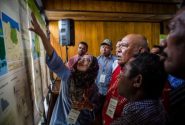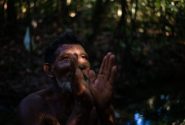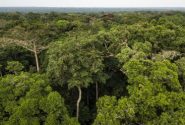PUNTA DEL ESTE, Uruguay (12 November 2012)_Small-scale farmers in many tropical nations depend primarily on their crops for survival, but without additional income generated by nearby forests, they would often be unable to weather through the hard times. This is why agricultural and forestry institutions should partner up when conducting research aimed at determining activities that will be most beneficial to communities and the environment, said scientists with the Center for International Forestry Research.
The perception often is that farmers only do one thing: farm.
“But growing or managing forests for wood and non-wood products, both for subsistence and sale is very common. “It is also a very sensible strategy, both in terms of maximising incomes and minimising risk,” said Peter Kanowski, Deputy Director General of CIFOR, at the Second Global Conference on Agricultural Research Development (GCARD2) in Uruguay. The conference discussed hopes for a future where agricultural innovation ratchets up production, and the welfare of small-scale farmers is assured.
Added Robert Nasi, Director at the CGIAR Research Program on Forests, Trees and Agroforestry: “This is what we are implementing in our forest, trees and agroforestry research program — working together with other research institutions and partners that span across the whole agriculture-forest gradient.”
Forests cover a third of the earth’s surface and one billion people depend on forest resources for their everyday lives. Forests also provide essential services to mainstream agriculture, meaning future food supplies could be compromised should deforestation continue at a staggering pace.
Research from the Poverty and Environment Network (PEN), the largest and most comprehensive global analysis of tropical forests and poverty indicates that on average 75 percent of the incomes of small-scale farmers comes from their crops.
But it’s the remaining 25 percent, primarily from the forest, that is often most important,
Especially, said Nasi, “during periods of crisis…when you have a drought, when you have food shortages.”
This rich, natural habitat provides a second source of income — through the sale of meat, wild fruit, bark, medicines, and micro-nutrients — but also contributes in indirect ways, by providing ecosystem services to the yields and crops, like water regulation and pollination.
And this is key, not just for farmers to understand, but for agricultural and forestry researchers, as well.
“They have to recognise that they are just of the same portfolio,” said Kanowski, adding that only by partnering up will researchers be able to deliver outcomes that work for communities.
Farmers also need to understand the risks of having farmers invest all of their land and labor producing a single crop (for biofuels or for feedstocks for animals, for instance).
Small-holders would be better off diversifying their activities, drawing from trees and other products in the forests and — depending on their situation — on some food crops.
The benefits are in income, but also in terms of resiliency and risk management.
CIFOR, an organisation with more than 200 researchers and support staff, would not be able to carry out its work if it didn’t team up with other researchers who are based in institutions and in countries with complementary skills, Kanowski said.
“On one level, partnerships are fundamental to actually doing our research, and on another, our research relies on partnerships to have an effect,” he said.
“We rely on partnerships in varying forms for our audiences to hear and understand the results of our research.”
Kanowski said he and his colleagues also rely on counterparts in the development community, who are working in national implementation agencies, to engage with the research they do.
Together, the research is “translated into implementation strategies, which will change people’s life for the better.”
Nasi concurred: “We have to remind the agricultural world that there is something beyond the fields: forests and trees,” he said.
“We need to keep the flag waving saying ‘We are here, you are not alone’.”
The CGIAR Research Program on Forests, Trees and Agroforestry: Livelihoods, Landscapes and Governance is lead by the Center for International Forestry Research in partnership with Bioversity International, the International Center for Tropical Agriculture and the World Agroforestry Centre. The centers collaborate with leading national research institutes and other organisations to maximize outreach and share research results with policy and practitioner partners , who can use and share this knowledge on the ground in the developing world.
We want you to share Forests News content, which is licensed under Creative Commons Attribution-NonCommercial-ShareAlike 4.0 International (CC BY-NC-SA 4.0). This means you are free to redistribute our material for non-commercial purposes. All we ask is that you give Forests News appropriate credit and link to the original Forests News content, indicate if changes were made, and distribute your contributions under the same Creative Commons license. You must notify Forests News if you repost, reprint or reuse our materials by contacting forestsnews@cifor-icraf.org.












